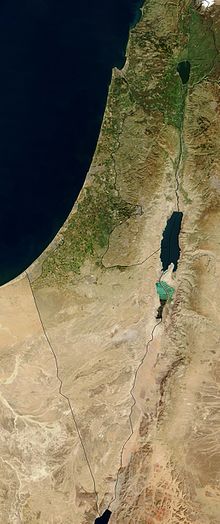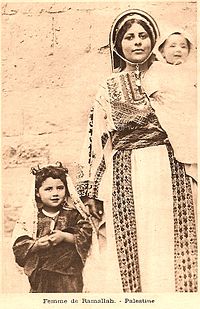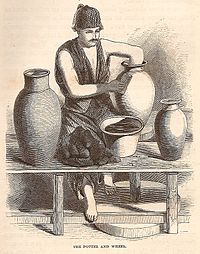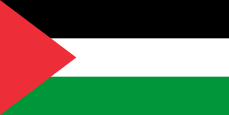Outline of the State of Palestine



The following outline is provided as an overview of and topical guide to the State of Palestine:
Palestine – country in the Middle East, politically under the jurisdiction of the Palestinian government and the Hamas Government in Gaza. Since the Palestinian Declaration of Independence in 1988 and the consequent admission into UN as an observer state in 2012, Palestine is today recognized by three-quarters of the world's countries.[1] Its proclaimed capital is East Jerusalem, and Ramallah is its administrative center. Although recently promoted to a non-member state status in the UN, the State of Palestine does not exert full control of its territory and has historically turbulent relations with Israel and much of the west.
General reference
- Pronunciation: /ˈpælɪstaɪn/ PAL-ist-eyen
- Common English country names: State of Palestine; Palestine
- Official English country name: U.S. State Department: Palestinian Territories [2]; E.U. ISO 3166-2: Palestine, State of [3]; UN-affiliated organizations: Palestine, State of [4]
- Common endonym(s): Filasṭīn (Arabic: فلسطين, also transliterated Falasṭīn and Filisṭīn)
- Official endonym(s): Dawlat Filasṭīn (Arabic: دولة فلسطين)
- Adjectival(s): Palestinian
- Demonym(s): Palestinian people (aš-šaʿb al-filasṭīnīy), Palestinians (al-filasṭīnīyūn) or Palestinian Arabs (al-ʿarab al-Filasṭīnīyūn)
- Etymology: Timeline of the name Palestine, Place names in Palestine
- ISO country codes: PS, PSE, 275
- ISO region codes: See ISO 3166-2:PS
- Internet country code top-level domain: .ps
Geography of the State of Palestine

- State of Palestine location:
- Northern Hemisphere and Eastern Hemisphere
- Eurasia
- Time zone: UTC+02, summer UTC+03
- Extreme points of Palestine
- High: Mount Nabi Yunis 1,030 m (3,379 ft)
- Low: Dead Sea −412 m (−1,352 ft) – lowest point on the surface of the Earth
- Land boundaries: Officially undefined, figures given are the de facto boundaries of the Green Line as they apply to the West Bank and Gaza Strip (See also Israeli West Bank barrier, Israeli Gaza Strip barrier and the Seam Zone)
- Total: 466 km (290 mi)
- Coastline (Gaza Strip): 40 km (25 mi)
- Coastline (West Bank): 0 km (0 mi)
Note: West Bank includes the northern portion of the Dead Sea with a 40 km (25 mi) shoreline.
- Population of Palestine:
- Palestinian population worldwide, including diaspora: est. 10,000,000 - 11,000,000
- Population of Palestine: est. 3,800,000
- Area of Palestine:
- State of Palestine (post-2013): claimed area 6,220 km2 (2,400 sq mi) (de facto control of 2,488 km2 (961 sq mi)); The West Bank (including East Jerusalem) is (5,860 km2 (2,260 sq mi) and the Gaza Strip is 360 km2 (140 sq mi)
- Atlas of Palestine
Environment of Palestine





- Climate of the State of Palestine
- List of ecoregions in the State of Palestine
- Renewable energy in Palestine
- Geology of Palestine
- Protected areas of Palestine
- Wildlife of Palestine
- Flora of the State of Palestine
- Fauna of Palestine
- Palestinian Environmental NGOs Network
Natural geographic features of Palestine
- Glaciers of Palestine: N/A
- Islands of Palestine: N/A
- Lakes of Palestine
- List of seas in Palestine
- Mountains of Palestine
- Rivers of Palestine
- Wells of Palestine
- Valleys of Palestine
- Jordan Rift Valley
- Wadi Qelt
- Villages named for Wadis ("Valleys")
- Wadi al-Arayis
- Wadi Ara, Haifa (depopulated in 1948)
- Wadi al-Far'a
- Wadi Fukin
Regions of Palestine
Regions of the State of Palestine
Ecoregions of Palestine
List of ecoregions in Palestine
Administrative divisions of Palestine
Administrative divisions of the State of Palestine
- Palestinian Governorates: 16 (11 in the West Bank, 5 in Gaza)
- Jerusalem Governorate: Jerusalem District
- Bethlehem Governorate: Bethlehem District
- Deir Al-Balah Governorate: Deir Al-Balah District
- Gaza Governorate: Gaza District
- Hebron Governorate: Hebron District
- Jenin Governorate: Jenin District
- Jericho Governorate: Jericho District
- Khan Yunis Governorate: Khan Younis District
- Nablus Governorate: Nablus District
- North Gaza Governorate: North Gaza District
- Qalqilya Governorate: Qalqilya District
- Rafah Governorate: Rafah District
- Ramallah and Al-Bireh Governorate: Ramallah and Al-Bireh District
- Salfit Governorate: Salfit District
- Tubas Governorate: Tubas District
- Tulkarm Governorate: Tulkarm District
- Cities under Palestinian administration
Demography of Palestine
Government and politics of Palestine


- Capital of Palestine:
- Proclaimed capital: East Jerusalem (also proclaimed by Israel)
- de facto capital: Ramallah
- Elections in Palestine
- Palestinian government
- List of political parties in the State of Palestine
- Taxation in Palestine
Branches of the government of Palestine
- NB. As a result of the Fatah-Hamas conflict, there is a dispute over the Presidency and Prime Ministership of the State of Palestine.
- Ministries of Palestine
Legislative branches of the government of Palestine
- Palestinian Legislative Council (Palestine, unicameral)
- Palestinian National Council (PLO, unicameral, parliament-in-exile[3])
Judicial branch of the government of Palestine
- According to the Constitution of Palestine, all courts relating to the country shall be independent.
Local governance in Palestine
Foreign relations of Palestine
- Foreign relations of Palestine
- Diplomatic missions in Palestine
- List of diplomatic missions of the State of Palestine
Palestine and the United Nations

- United Nations Partition Plan for Palestine
- United Nations Palestine Commission
- United Nations Relief and Works Agency for Palestine Refugees in the Near East (UNRWA)
- United Nations resolutions concerning Palestine
- United Nations Special Committee on Palestine (UNSCOP)
- Committee on the Exercise of the Inalienable Rights of the Palestinian People
- International Day of Solidarity with the Palestinian People
- Palestinian right of return
- Palestine and the United Nations
International organization membership

Palestine is a member in a number of international organizations. In others, it enjoys affiliation in a lesser capacity or under another designation (such as PLO or Palestinian National Authority). In the list below, if the membership is not full or not for the state of Palestine, the type and name of affiliation is denoted in parentheses.
- Arab Fund for Economic and Social Development (AFESD)
- Arab League (AL)
- Arab Monetary Fund (AMF)
- Council of Arab Economic Unity (CAEU)
- FIFA (Asian Football Confederation (AFC)
- Group of 77 (G77)
- International Olympic Committee (IOC)
- International Trade Union Confederation (ITUC) (affiliate member)
- International Telecommunication Union (ITU) (non-voting observer status)
- International Organization for Standardization (ISO)
- International Paralympic Committee (IPC)
- International Federation of Red Cross and Red Crescent Societies (IFRC)
- International Committee of the Red Cross (ICRC)
- Islamic Development Bank (IDC)
- Organisation of Islamic Cooperation (OIC)
- Non-Aligned Movement (NAM)
- United Nations (UN) (observer)
- UNESCO
- UNIDO
- Universal Postal Union (UPU)
- World Health Organization (WHO) (observer status) (see also: Palestine's application to the WHO)
- World Intellectual Property Organization (WIPO)
- OPCW
- ICC
- Interpol
- UNCTAD
- UNICEF
- IPU
International aid to Palestine
International solidarity movements
Law and order in Palestine
- Palestinian National Charter
- Crime in Palestine
- Human rights in Palestine
- Law enforcement in Palestine
- Prostitution in Palestine
Military of Palestine
Military of the State of Palestine
- Command
- Commander-in-chief: N/A
- Ministry of Defense of Palestine: N/A
- Commander-in-chief: N/A
- Forces
- Army of the Palestine: N/A
- Navy of the Palestine: N/A
- Air Force of the Palestine: N/A
- Special forces of Palestine:
- Military history of Palestine
- Military ranks of Palestine: N/A
Paramilitary forces of Palestine
Palestinian National Security Forces
Irregular Palestinian forces
- Al-Aqsa Martyrs' Brigades (armed wing affiliated with Fatah)
- al-Quds Brigades (armed wing of Palestinian Islamic Jihad)
- Izz ad-Din al-Qassam Brigades (armed wing of Hamas)
- Popular Front for the Liberation of Palestine - General Command (PFLP-GC) (armed wing of the PFLP)
- Popular Resistance Committees
- Palestinian domestic weapons production
International civilian organizations in Palestine
- European Union Border Assistance Mission Rafah
- European Union Police Mission for the Palestinian Territories
- Temporary International Presence in Hebron
History of Palestine


- Military history of Palestine
- Sinai and Palestine Campaign (1915–1918)
- Battle of Megiddo (1918)
- 1920 Palestine riots
- Jaffa riots
- 1929 Palestine riots
- 1936–1939 Arab revolt in Palestine
- Bombing of Palestine in World War II
- 1948 Palestine war
- 1948 Palestinian expulsion and flight
- 1949–56 Palestinian exodus
- 1967 War
- 1967 Palestinian exodus
- Battle of Karameh
- Black September in Jordan (1970)
- Lebanese Civil War
- Second Intifada (2000–05)
- Gaza–Israel conflict
- Political history of Palestine
Palestinian culture
| Part of a series on |
| Palestinians |
|---|
 |
| Demographics |
| Politics |
|
| Religion / religious sites |
| Culture |
| List of Palestinians |







- Archaeology in the State of Palestine
- Architecture of Palestine
- Palestinian costumes
- Palestinian cuisine
- Festivals of the State of Palestine
- Languages of Palestine
- Communications in Palestine
- Print media of the State of Palestine
- Palestinian Broadcasting Corporation
- Radio in Palestine
- Television in the State of Palestine
- National symbols of Palestine
- Palestinians
- National holidays of the State of Palestine
- Records of Palestine
- Religion in Palestine
- Christianity in Palestine
- Islam in Palestine
- Sites holy to Christians, Jews, and Muslims
- Cave of the Patriarchs (Al-Haram Al-Ibrahimi)
- Joseph's Tomb
- Jacob's Well (also holy to Samaritans)
- Rachel's Tomb (Bilal ibn Rabah)
- Tomb of Samuel (Nabi Samwil)
- Judaism in Palestine
- Samaritans in Palestine
- Ahmadiyya in Palestine
Art in Palestine
- Palestinian art
- Museums in Palestine
- Cinema of the State of Palestine
- Palestinian handicrafts
- Palestinian literature
- Music of Palestine
- Palestinian Theatre
Sports in Palestine
- Football in the State of Palestine
- Hammams (bathhouses)
- Palestine Olympic Committee
- Palestine at the Paralympics
- Palestinian Scout Association
- Girl Guides of Palestine
Economy and infrastructure of Palestine

- Economic rank, by nominal GDP (2007): 134th (one hundred and thirty fourth)
- Agriculture in Palestine
- Banking in Palestine
- Communications in Palestine
- List of companies of Palestine
- G.ho.st
- Palestinian Airlines (defunct)
- Paltel
- Taybeh Brewery
- National Trade Union of Palestine
- Fair Trade organizations in the State of Palestine
- Currency of Palestine: dinar/sheqel
- Energy in the State of Palestine
- Mining in the State of Palestine
- Public squares in Palestine
- Tourism in Palestine
- Transport in Palestine
- Water supply and sanitation in Palestine
- Palestine Stock Exchange
Healthcare in Palestine
Housing in Palestine
Education in the Palestine


- Education in Palestine
- Education Ministry
- Universities and colleges of Palestine
- Student organizations in Palestine
- Student organizations supporting Palestine
- Palestinian cultural club
- Palestine Solidarity Movement
- Solidarity for Palestinian Human Rights
Books on Palestine
- Correcting a Mistake: Jews and Arabs in Palestine/Israel, 1936-1956
- The Ethnic Cleansing of Palestine
- Palestine (comics)
- Palestine Peace Not Apartheid
- Underground to Palestine
See also
- List of international rankings
- List of Palestine-related topics
- Years in Palestine
- 2023 Israel–Hamas war
- Outline of Asia
- Outline of geography
- Outline of Israel
References
- ^ [1] "Note that the term Palestine has historically referred to the region which today incorporates Israel as well as the Palestinian territories. The current position was expressed by Mahmoud Abbas in his September 2011 speech to the United Nations: 'When we adopted this program, we were taking a painful and very difficult step for all of us, especially those, including myself, who were forced to leave their homes and their towns and villages, carrying only some of our belongings and our grief and our memories and the keys of our homes to the camps of exile and the Diaspora in the 1948 Al-Nakba, one of the worst operations of uprooting, destruction and removal of a vibrant and cohesive society that had been contributing in a pioneering and leading way in the cultural, educational and economic renaissance of the Arab Middle East. Yet, because we believe in peace and because of our conviction in international legitimacy, and because we had the courage to make difficult decisions for our people, and in the absence of absolute justice, we decided to adopt the path of relative justice – justice that is possible and could correct part of the grave historical injustice committed against our people. Thus, we agreed to establish the State of Palestine on only 22% of the territory of historical Palestine – on all the Palestinian Territory occupied by Israel in 1967.'"
- ^ Martijn Schoonvelde (26 June 2009). "Palestinian Territories". Archived from the original on 3 June 2009. Retrieved 26 July 2009.
- ^ Sela and Ma'oz, 1997, p. 16.
Bibliography
- Roberto Remo Bissio, ed. (1995). The world: a Third World guide 1995-96 (Illustrated ed.). Instituto del Tercer Mundo. ISBN 9780855982911.
- Milton-Edwards, Beverley (2008), The Israeli-Palestinian Conflict: A People's War (Illustrated ed.), Taylor & Francis, ISBN 9780415410434
- Kogan Page (2004). Middle East Review (27th, illustrated ed.). Kogan Page Publishers. ISBN 9780749440664.
- Said, Edward W.; Hitchens, Christopher (2001), Blaming the victims: spurious scholarship and the Palestinian question (2nd, illustrated ed.), Verso, ISBN 9781859843406
- Sela, Avraham; Ma'oz, Moshe (1997), The PLO and Israel: from armed conflict to political solution, 1964-1994 (Illustrated ed.), Palgrave Macmillan, ISBN 9780312129064
External links
- The Hope Simpson Report (London, 1930) [5]
- Palestine Royal Commission Report (the Peel Report) (London, 1937) [6]
- Report to the Council of the League of Nations (1928) [7]
- Report to the Council of the League of Nations (1929) [8]
- Report to the Council of the League of Nations (1934) [9]
- Report to the Council of the League of Nations (1935) [10]
- www.mideastweb.org - A website with a wealth of statistics regarding population in Palestine
- Coins and Banknotes of Palestine under the British Mandate
- WorldStatesmen- Maps, flags, chronology, see Israel and Palestinian National Authority
- hWeb - Israel-Palestine in Maps
- Palestine Fact Sheet from the Common Language Project
- . Encyclopædia Britannica. Vol. 20 (11th ed.). 1911. pp. 600–626.
- Liberal Democrat Friends of Palestine
- History of the Palestine Problem, UN website
- Maps


